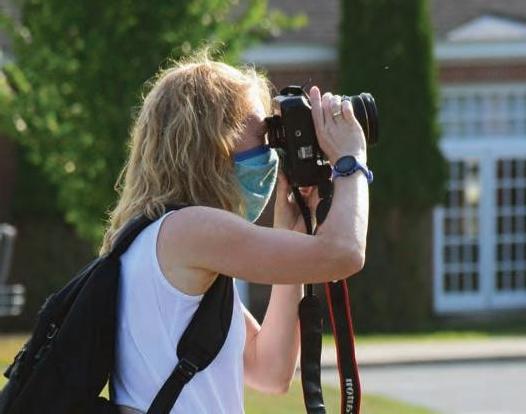
3 minute read
letter from the editor
e Limits of a Photograph
The author capturing move-in days at Cardigan

When I have a camera in my hands, my visual senses become super alert, the to-do list that continually loops in my head quiets, and I am present to the world around me. I look for the details that will tell a story—dew drops lined up along the edge of an Echinacea petal, catching the morning sun in my mother’s garden; my three-month-old nephew playing with his first Tonka truck, his little hands exploring with imprecise but intense fascination; the Cardigan boys sailing on Canaan Street Lake, learning to interpret and harness the power of the wind. Looking through my lens, I compose a shot and watch how the light is reflected and absorbed. What effect will I create by photographing from below an object, or perhaps from above? If I wait, just a little longer, will the boy in my viewfinder look up and smile?
Even at the end of a long day, I usually don’t wait to look at the photographs on my computer. As my husband and daughters turn out the kitchen lights and head upstairs to bed, I remain at my desk sorting pictures and adjusting the settings. In a world that is always changing, I gain a good dose of pleasure in looking through moments frozen in time—a soccer player captured in perfect athletic balance, leaning into a turn that seems to defy gravity; a connection between two students, grappling with an idea, pens pressed to paper in a moment of intense concentration; quiet moments, happening off to the side of a main attraction, touches of affection, expressions of amazement.
This fall, however, I was surprised by how much the pandemic interfered with my joy of photographing the students and documenting the life of the School. While I know how important masks and social distancing have become in our daily lives, as a storyteller, I mourn their presence. Taking pictures of students in masks is like deleting entire paragraphs, if not chapters, from a novel.
Admittedly, aer six months of shooting only landscape photographs, it was a pleasure to have students back on campus in August. But quickly my colleague Martin Grant and I realized the limits of photographing students in their masks. No matter what we tried— students waving, students jumping, students giving the camera thumbs up—the photos we took were flat. e color, the composition, the focus, the angle of the light—nothing mattered when their faces were obscured.
It was a great relief when we made it through the first two weeks of school without any COVID-19cases; most importantly, it meant that everyone was healthy, but it also meant mask restrictions could be relaxed. In the classrooms, students didn’t have to wear masks if they were seated at their desks and socially distanced from their classmates, and during outdoor athletic practices, students could train without covering their faces. Martin and I were once again able to capture the expressions on students’ faces, albeit from a distance.
Even at its best, though, photography has its limits, and not just when capturing the expressions on people’s faces. Aer months of silence on campus, listening to children’s voices echoing across Marrion Field for the first time was a simple pleasure. And as the sounds of excavators and power tools faded and summer construction ended, the boys’ voices took over the new classrooms and workshops in Wallach, proving that bricks and mortar don’t matter nearly as much as what takes place inside a building’s walls. e excited chatter of the boys as they began to problem solve and discover and share ideas made Wallach complete.
As you read this issue of the Chronicle, there will be some things missing. In many cases the boys’ faces will be obscured behind the masks that are protecting them, protecting all of us. And you won’t be able to hear their voices, the joy and excitement of victory and accomplishment, the hard conversations filled with growth and learning, the ordinary moments captured in friendly greetings. I hope, however, as you flip through the pages, you will use your imagination to complete the pictures and join me in the simple pleasure of being a part of a school that is open and thriving, despite a pandemic. r
Emily Magnus, Editor emagnus@cardigan.org






